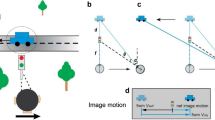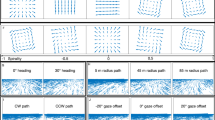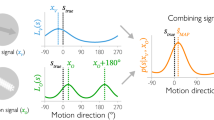Abstract
WHEN a person walks through a rigid environment while holding eyes and head fixed, the pattern of retinal motion flows radially away from a point, the focus of expansion (Fig. la)1,2. Under such conditions of translation, heading corresponds to the focus of expansion and people identify it readily3. But when making an eye/head movement to track an object off to the side, retinal motion is no longer radial (Fig. 1b)4. Heading perception in such situations has been modelled in two ways. Extra-retinal models monitor the velocity of rotational movements through proprioceptive or efference information from the extraocular and neck muscles and use that information to discount rotation effects5. Retinal-image models determine (and eliminate) rotational components from the retinal image alone6–12. These models have been tested13,14 by measuring heading perception under two conditions. First, observers judged heading while tracking a point on a simulated ground plane. Second, they fixated a stationary point and the flow field simulated the effects of a tracking eye movement. Extra-retinal models5 predict poorer performance in the simulated condition because the eyes do not move. Retinal-image models6–12 predict no difference in performance because the two conditions produce identical patterns of retinal motion. Warren and Hannon13,14 observed similar performance and concluded that people do not require extra-retinal information to judge heading with eye/head movements present, but they used extremely slow tracking eye movements of 0.2–1.2 deg s−1; a moving observer frequently tracks objects at much higher rates (L. Stark, personal communication). Here we examine heading judgements at higher, more typical eye movement velocities and find that people require extra-retinal information about eye position15 to perceive heading accurately under many viewing conditions.
This is a preview of subscription content, access via your institution
Access options
Subscribe to this journal
Receive 51 print issues and online access
$199.00 per year
only $3.90 per issue
Buy this article
- Purchase on Springer Link
- Instant access to full article PDF
Prices may be subject to local taxes which are calculated during checkout
Similar content being viewed by others
References
Gibson, J. J. The Perception of the Visual World (Houghton Mifflin. Boston, 1950).
Gibson, J. J. The Senses Considered as Perceptual Systems (Houghton Mifflin, Boston, 1966).
Warren, W. H., Morris, M. W. & Kalish, M. J. exp. Psych. 14, 646–660 (1988).
Regan, D. & Beverley, K. I. Science 215, 194–196 (1982).
von Hoist, E. Anim. Behav. 2, 89–94 (1954).
Longuet-Higgins, H. C. & Prazdny, K. Proc. R. Soc. Lond. B 208, 385–397 (1980).
Rieger, J. H. & Lawton, D. T. J. opt. Soc. Am. A 2, 354–360 (1985).
Heeger, D. J. & Jepson, A. D. int. J. comp. Vis. (in the press).
Bruss, A. R. & Horn, B. K. P. Comp. Vis. Graph Im. Proc. 21, 3–20 (1983).
Waxman, A. M. & Ullman, S. Int. J. robot. Res. 4, 72–94 (1985).
Droulez, J. & Cornilleau-Peres, V. Biol. Cybern. 62, 211–224 (1990).
Longuet-Higgins, H. C. Nature 293, 133–135 (1981).
Warren, W. H. & Hannon, D. J. Nature 336, 162–163 (1988).
Warren, W. H. & Hannon, D. J. J. opt. Soc. Am. A 6, 160–169 (1990).
Matin, L. in Symp. Study of Moton Perception (eds Wagenaar. W. A., Wertheim. A. H. & Leibowitz. H. W.) (Plenum, New York, 1981).
Warren, W. H., Blacknell, A. W., Kurtz, K. J., Hatsopoulous, N. G. & Kalish, M. L. Biol. Cybern. 65, 311–320 (1991).
Author information
Authors and Affiliations
Rights and permissions
About this article
Cite this article
Royden, C., Banks, M. & Crowell, J. The perception of heading during eye movements. Nature 360, 583–585 (1992). https://doi.org/10.1038/360583a0
Received:
Accepted:
Issue Date:
DOI: https://doi.org/10.1038/360583a0
This article is cited by
-
Coregistration of heading to visual cues in retrosplenial cortex
Nature Communications (2023)
-
Cortical Mechanisms of Multisensory Linear Self-motion Perception
Neuroscience Bulletin (2023)
-
Causal contribution of optic flow signal in Macaque extrastriate visual cortex for roll perception
Nature Communications (2022)
-
The effect of cellphone position on driving and gaze behaviour
Scientific Reports (2021)
-
When flow is not enough: evidence from a lane changing task
Psychological Research (2020)
Comments
By submitting a comment you agree to abide by our Terms and Community Guidelines. If you find something abusive or that does not comply with our terms or guidelines please flag it as inappropriate.



